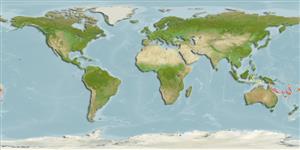Classification / Names
Nomi Comuni | Sinonimi | Catalog of Fishes(Genere, Specie) | ITIS | CoL | WoRMS | Cloffa
>
Pleuronectiformes (Flatfishes) >
Samaridae (Crested flounders)
Etymology: Plagiopsetta: Greek, plagios = oblique + Greek, psetta = grouper (Ref. 45335); stigmosa: Named for the distinct jet-black blotch on the pectoral fin, being one of the diagnostic characters of this species.
Environment: milieu / climate zone / depth range / distribution range
Ecologia
marino batidemersale; distribuzione batimetrica 280 - 330 m (Ref. 83388). Tropical
Distribuzione
Stati | Aree FAO | Ecosystems | Presenze | Point map | Introduzioni | Faunafri
Nova Bank, Chesterfield Plateau, Argo Bank and Capel Bank.
Size / Peso / Age
Maturity: Lm ? range ? - ? cm
Max length : 16.8 cm SL maschio/sesso non determinato; (Ref. 83388)
Short description
Chiavi di identificazione | Morfologia | Morfometria
Raggi dorsali molli (totale) : 71 - 78; Raggi anali molli: 55 - 62; Vertebre: 39 - 40. This species is distinguished by having the following set of characters: lateral line present on both sides, scales in lateral line 70-86; pectoral fin with jet-black blotch near posterior margin of third to fifth rays; caudal vertebrae 29-30 (Ref. 83388).
Life cycle and mating behavior
Maturità | Riproduzione | Deposizione | Uova | Fecundity | Larve
Mihara, E. and K. Amaoka, 2004. Pleuronectiform fishes from New Caledonian waters. Five species of the samarid genera Plagiopsetta and Samaris (Samaridae). in Marshall, B. & Richer de Forges, B. (eds), Tropical Deep-Sea Benthos, volume 23. Mémoires du Muséum national d’Histoire naturelle 191:611-635. (Ref. 83388)
IUCN Red List Status (Ref. 130435: Version 2024-1)
Threat to humans
Harmless
Human uses
Strumenti
Special reports
Download XML
Fonti Internet
Estimates based on models
Preferred temperature (Ref.
123201): 4.5 - 8.7, mean 6.6 °C (based on 78 cells).
Phylogenetic diversity index (Ref.
82804): PD
50 = 0.6250 [Uniqueness, from 0.5 = low to 2.0 = high].
Bayesian length-weight: a=0.00389 (0.00180 - 0.00842), b=3.12 (2.94 - 3.30), in cm total length, based on all LWR estimates for this body shape (Ref.
93245).
Trophic level (Ref.
69278): 3.7 ±0.4 se; based on size and trophs of closest relatives
Fishing Vulnerability (Ref.
59153): Low vulnerability (10 of 100).
